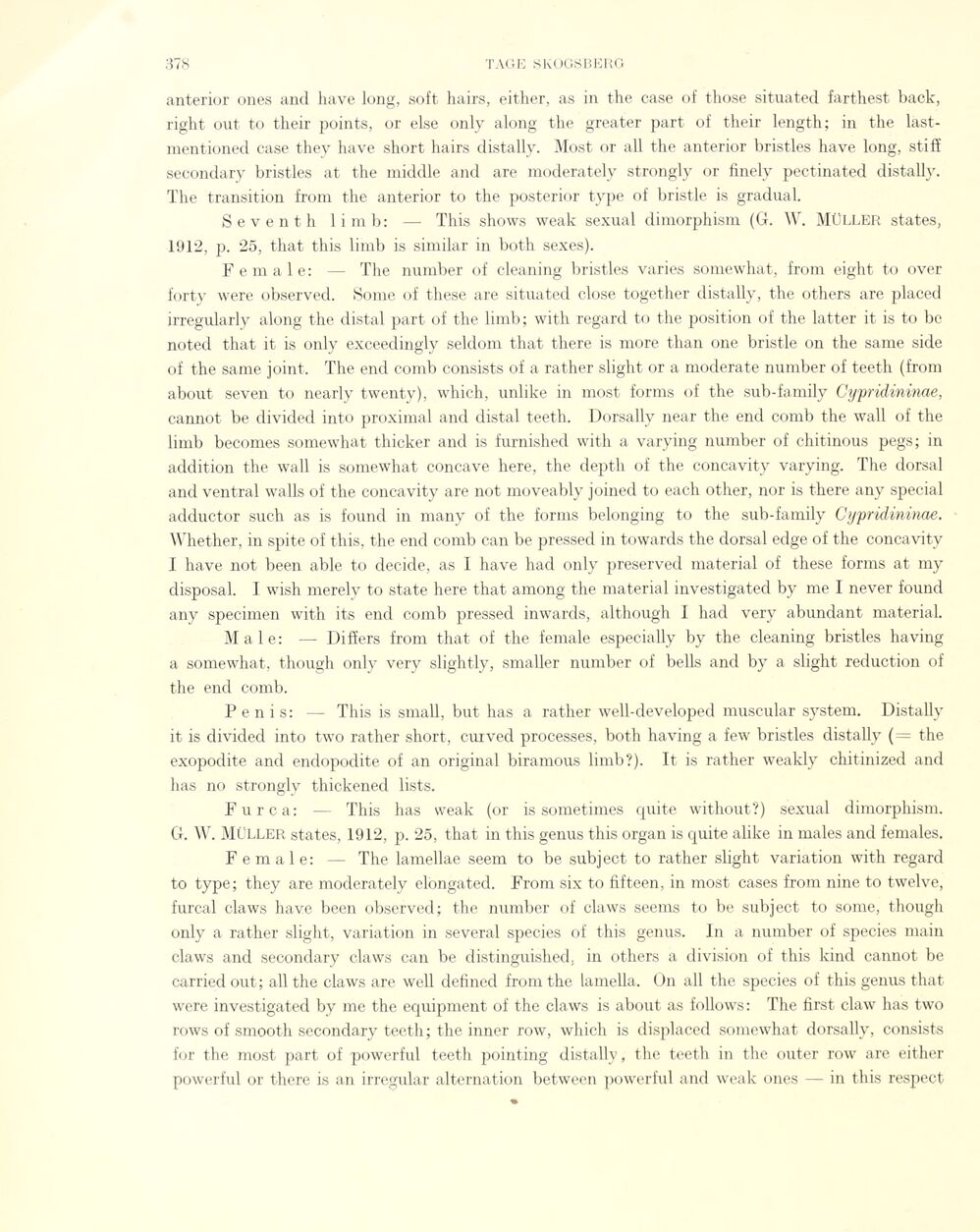
Full resolution (JPEG) - On this page / på denna sida - Sidor ...

<< prev. page << föreg. sida << >> nästa sida >> next page >>
Below is the raw OCR text
from the above scanned image.
Do you see an error? Proofread the page now!
Här nedan syns maskintolkade texten från faksimilbilden ovan.
Ser du något fel? Korrekturläs sidan nu!
This page has never been proofread. / Denna sida har aldrig korrekturlästs.
anterior ones and have long, soft hairs, either, as in the case of those situated farthest back,
right out to their points, or else only along the greater part of their length; in the
last-mentioned case they have short hairs distally. Most or all the anterior bristles have long, sti ff
secondary bristles at the middle and are moderately strongly or finely pectinated distallv.
The transition from the anterior to the posterior type of bristle is graduai.
Seventh li mb: — This shows weak sexual dimorphism (G. W. MÜLLER states,
1912, p. 25, that this limb is similar in both sexes).
Female: — The number of cleaning bristles varies somewhat, from eight to over
forty were observed. Some of these are situated close together distally, the others are placed
irregularly along the distal part of the limb; with regard to the position of the latter it is to be
noted that it is only exceedingly seldom that there is more than one bristle on the same side
of the same joint. The end comb consists of a rather slight or a moderate number of teeth (from
about seven to nearly twenty), which, unlike in most forms of the sub-family Cypridininae,
cannot be divided into proximal and distal teeth. Dorsally near the end comb the wall of the
limb becomes somewhat thicker and is furnished with a varying number of chitinous pegs; in
addition the •wall is somewhat concave here, the depth of the concavity varying. The dorsal
and ventral walls of the concavity are not mo vea bly joined to each other, nor is there any special
adductor such as is found in many of the forms belonging to the sub-family Cypridininae.
Whether, in spite of this, the end comb can be pressed in towards the dorsal edge of the concavity
I have not been able to decide, as I have had only preserved material of these forms at my
disposai. I wish merely to state here that among the material investigated by me I never found
any specimen with its end comb pressed inwards, although I had very abundant material.
Male: — Differs from that of the female especially by the cleaning bristles ha ving
a somewhat, though only very slightly, smaller number of belis and by a slight réduction of
the end comb.
Penis: — This is small, but has a rather well-developed muscular system. Distally
it is divided into two rather short, cuived processes, both having a few bristles distally (= the
exopodite and endopodite of an original biramous limb?). It is rather weakly chitinized and
has no strongly thickened lists.
Furca: — This has weak (or is sometimes quite without?) sexual dimorphism.
G. W. Müller states, 1912, p. 25, that in this genus this organ is quite alike in males and females.
Female: — The lamellae seem to be subject to rather slight variation with regard
to type; they are moderately elongated. From six to fifteen, in most cases from nine to twelve,
furcal claws have been observed; the number of claws seems to be subject to some, though
only a rather slight, variation in several species of this genus. In a number of species main
claws and secondary claws can be distinguished, in others a division of this kind cannot be
carried out; all the claws are well defined from the lamella. On all the species of this genus that
were investigated by me the equipment of the claws is about as follows: The first claw has two
rows of smooth secondary teeth; the inner row, which is displaced somewhat dorsally, consists
for the most part of powerful teeth pointing distally, the teeth in the outer row are either
powerful or there is an irregulär alternation between powerful and weak ones — in this respect
<< prev. page << föreg. sida << >> nästa sida >> next page >>